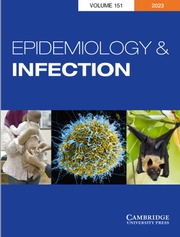Article contents
Genetical relationship between R plasmids derived from Salmonella and Escherichia coli obtained from a pig farm, and its epidemiological significance
Published online by Cambridge University Press: 15 May 2009
Summary
A total of 475 Salmonella strains belonging to 5 serovars, isolated from a pig farm which had been heavily contaminated with Salmonella for the past 2 years were tested for antibiotic susceptibility and detection of R plasmids. Thirty-three Escherichia coli isolates from the same farm were also examined in a similar way.
Out of 475 strains 348 (73·2%) were resistant to one or more antibiotics such as tetracycline (Tc), streptomycin (Sm), sulfadimethoxine (Su), chloramphenicol (Cm) and kanamycin (Km), and 247 (85·2%) out of 290 strains belonging to 3 serovars examined harboured conjugative R plasmids. There was no change in the pattern of drug resistance during this survey nor any variation in the pattern of resistance of R plasmids, whatever the serovar. The antibiogram pattern Tc Sm Su, mainly S. typhimurium, was common among Salmonella strains. Among the transferred resistance patterns, the thermosensitive R plasmids conferring the Te marker detected in this study were Fi-, and belonged to incompatibility group H1, whereas the R plasmids conferring Sm Su resistances which coexisted in the same host were Fi+, and compatible with the reference R plasmids tested. The la plasmid conferring Cm resistance alone was isolated from S. anatum and the FII plasmid conferring Sm Km resistances was also isolated from S. typhimurium. In contrast, the 33 E. coli strains examined were resistant to three or five antibiotics and most of the resistance markers were located on conjugative R plasmids. la plasmids conferring Cm resistance alone or FIT plasmids conferring Cm or Km markers were common in the E. coli strains. H1 and H2 plasmids conferring multiple resistance markers were also found in them. The genetic properties of R plasmids derived from Salmonella or E. coil strains are compared, and the potential spread of R plasmids between strains of Salmonella andE. coli is discussed.
- Type
- Research Article
- Information
- Copyright
- Copyright © Cambridge University Press 1980
References
REFERENCES
- 6
- Cited by




